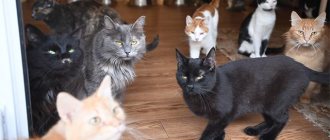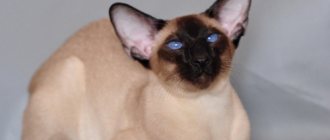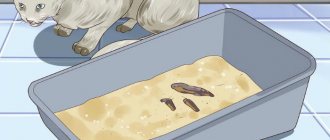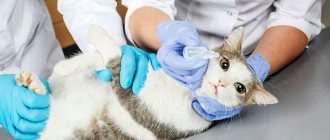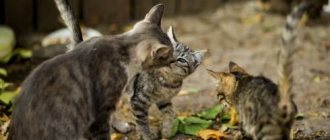Allergies to cats are no more common in people than allergies to dogs. There is a misconception that the fur of your favorite fluffies is to blame. Allergic reactions actually occur to the Fel D1 protein, which is found in animal saliva, urine, sebum, sweat and urine. It doesn’t matter whether your pet has fur or not, there is no escape from physiological secretions.
There are hypoallergenic cats in the world that secrete a minimal amount of protein, which allows allergy sufferers to comfortably live with them in the same living space. In this article we will tell you about the breeds that people who are allergic to animals should pay attention to.
Causes of allergies to cats
Many people mistakenly think that the cause of allergies is animal fur, but in fact, allergies are caused by the Fel D1 protein (Laden allergen), which is found absolutely in the physiological secretions of cats: in saliva, sweat, urine, sebum. While licking, the cat transfers protein particles to the animal's fur, and the hairs, in turn, are spread throughout the room.
Reference. The Fel D1 protein is extremely persistent and remains in the environment for up to six months, even if the cat no longer lives in the house.
Scientists note that true allergies to cat hair are extremely rare . At the same time, about 15% of the world's population suffers from allergies to animals. If your body breaks out in an itchy rash when you come into contact with a cat, but you calmly wear a wool coat, then the cause of the allergic reaction lies in the irritant protein.
Symptoms of a cat allergy:
- rhinitis;
- swelling of the nasal mucosa;
- itching and burning in the throat and nose;
- sneezing,
- dyspnea,
- cough,
- swelling of the nasopharynx;
- dryness, itching and burning of the skin;
- rash and blisters on the skin;
- stomach ache;
- nausea;
- inflammation of the conjunctiva, excessive lacrimation,
- lethargy, irritability, headache.
Signs of allergies are varied and appear with different intensities . Much depends on the characteristics of the human body and the cat breed.
Sphinx
Hairless cat breed. The complete absence of fur is the result of a natural genetic failure. There have been periodic reports of hairless kittens. Breeders became interested in them around 1960. The date of complete formation of the breed can be considered 1970.
The North American version of the Sphinx is called the Canadian Sphinx. Two varieties of the Sphynx, the Donskoy and the Peterbald, were later bred in Russia. In Ukraine, a breed called the “Ukrainian Levkoy” was developed. That is, the Sphynx is a group of cat breeds.
Sphynx cats are moderate-sized cats. The body is muscular with a rounded chest and a noticeable belly. The head is wedge-shaped with large eyes and an elongated nose. The mustache pads are modest. The ears are large, with a slight deviation to the sides. Limbs of normal size. The hind ones are slightly longer than the front ones.
Hairlessness is not absolute. On the entire body or selectively: downy hair can grow on the tail and paws. Cats are smart. Attached to the owner. Need constant attention. In many ways, their behavior depends on relationships with people at a very early age.
Are there hypoallergenic cat breeds?
There is a misconception that there are hypoallergenic cat breeds in the world that do not cause discomfort. It is erroneous because not everyone is familiar with the nature of allergic reactions. Thus, the Sphynx is considered a hypoallergenic breed, but the physiological secretions of these cats, just like Persian or any other cats, contain the Fel D1 protein. Unfortunately, there are no breeds that do not cause allergies in nature.
However, some cat breeds produce fewer allergens but still cause unwanted symptoms . Allergists advise choosing a pet based on coat type: avoid animals with thick undercoat and give preference to hairless breeds and cats with dense, curly fur, reminiscent of astrakhan fur. The latter lose hair less often, which means less hair is spread around the house. Representatives of the Cornish Rex breed have this type of coat.
Hairless cats also excrete proteins, but they are easier to remove from bare skin if you bathe the animals 1-2 times a week.
Interesting. Light-colored cats are considered less allergenic because they produce fewer allergens than dark-colored cats. In addition, cats are more allergenic than cats.
After you have chosen a hypoallergenic cat
It's important to understand that a "hypoallergenic" cat may not be the panacea you expected. Before you finally adopt a cat, spend some time with it to make sure your allergies remain under control.
If you are adopting a cat from a breeder, ask if you can return the cat if your allergies become noticeable (reputable breeders will allow you to return the cat). Even better, if you adopt from a shelter, they will always take the cat back.
There are rules that will help minimize the release of allergens, and it doesn’t matter whether the breed is hypoallergenic or not:
Do these breeds require any special care?
There are few tips for caring for hypoallergenic breeds:
- bathe 3 times a week;
- change the bedding frequently or wash it;
- When it comes to hairless cats, wipe them with wet wipes without alcohol;
- clean your mouth every 3 weeks;
- for elves and Sphynxes, orientals, clean the ears with a damp cotton wool pad once a week;
- brush cats' fur once a week;
- The Burmese cat needs to be brushed and rubbed with chamois once a week to maintain a shiny coat.
Cost of treatment
| Name | Cost, rub. | |
| 1 | Initial appointment with a doctor, doctor of medical sciences | 7500* |
| 2 | Procedures included as prescribed by a doctor: | |
| UZIS | 2700 | |
| Ozone ultraviolet sanitation | 450 | |
| Laser photoreactive therapy | 1800-2600 | |
| Application of a microcompress into the nasal cavity | 700 | |
| Application of gum-propolis suspension to mucous membranes | 600 | |
| 3 | Final examination by a doctor based on the results of treatment | 1000 |
* — When paying for the full course of treatment procedures, the cost of a doctor’s appointment is included in the amount of treatment. The course of treatment is prescribed by a doctor. The course duration is 7-12 sessions depending on the diagnosis.
Russian blue
Two blue kittens were exported from Arkhangelsk to Britain in 1860. A short sea voyage marked the beginning of the now popular breed - Russian Blue. According to another version, back in the 18th century, so-called “sea” cats were known in Arkhangelsk. They were not at all afraid of water and successfully destroyed ship rats. On merchant ships, cats came to Britain and became the ancestors of the Russian Blue breed.
From England, cats spread across Europe and went overseas. Russian Blues have crossed with other domestic cats, but have retained their best qualities. Blue cats from Arkhangelsk are moderate-sized animals with short, plush hair.
The cat has a wedge-shaped head, the ears are set vertically. Muzzle with well defined whisker pads and large, almond-shaped, almost round eyes. The emerald green gaze of the widely spaced eyes seems meaningful and very attentive.
The body is muscular, the bones are of medium weight. The color is uniform, gray-blue. There may be a predominance of gray or blue tones. The Russian Blue's character is soft and delicate. The cat is responsive, but not intrusive. Oriental is a hypoallergenic cat breed ; Almost ideal for children
Standards
Outwardly, the Oriental cat gives the impression of a graceful and graceful animal. Many people think that because of her thin bones, she has a fragile body. Not at all: representatives of this breed are hardy, strong and prefer to lead an active lifestyle. Adult Oriental cats weigh approximately 4-5 kg, males - 5-6. Height at withers: 23-35 cm.
| Standard | Description |
| Head | Wedge-shaped, with a pointed, neat muzzle. You can draw an even and straight line from the tip of the chin to the tip of the nose. There is no bulge in the eye area. The nose is long, straight, there is no break between it and the frontal bone. The jaw is of medium size, as is the chin. |
| Neck | Graceful, long. |
| Ears | Large, elongated, but look organic. The base is wide, the tips are rounded. |
| Torso | Slender, long, tube-shaped. Hips and shoulders fit into the line of the torso. The bones are thin. |
| Eyes | Large, almond-shaped, inner corners are lowered down. Widely spaced. The color is green, with a small admixture of yellow allowed. Exception: white oriental cats (sky blue eye color). |
| Paws | Long and thin. The height of the hind limbs is greater. The pads are round and smooth. |
| Tail | Long, curving. Compared to the rest of the body, the tail is the fluffiest part. |
| Wool | The coat is silky, soft and smooth to the touch. There is no downy undercoat, so the hairs lie tightly to the skin. At first glance, it seems that the coat looks shorter than it actually is. |
Defects: strabismus; bulging eyeballs; small distance between the eyes; The width of the hips exceeds the width of the shoulders.
Oriental cats are distributed throughout the world, as are Siamese cats. However, despite the significant competition between nurseries, the price tag for a kitten will be quite high.
Pet-class Orientals (purebred, but with significant flaws in the exterior) will cost about 10 thousand rubles, breed-class Orientals, which are allowed for breeding, will cost from 25 thousand rubles. The price for show-class kittens is even higher. The price is set, depending on the characteristics of the kitten, by a special commission.
Character and behavior
From their distant ancestors - the Siamese - oriental cats inherited affection for humans. Having chosen their owner, they will be faithful to him until the end of their days. Not a single event in the home will take place without their participation: be it cleaning, repairs, making dumplings or watching a movie. They are big fans of chasing from room to room with a rubber ball, and also of jumping higher.
And we assure you - there are not many places in your house where a furry mischief cannot get into. Sometimes using curtains instead of stairs. So, if you want to minimize the risk of damage to furniture and home textiles, install a gaming complex in a free corner.
Representatives of this amazingly friendly breed are friendly to all household members and guests, even if they see them for the first time in their lives. After sniffing the stranger for a couple of minutes, they will jump on the sofa next to him and expose their backs for “scratching.”
Orientals are very kind to children, and the younger the child, the more careful they will behave around him. However, if the baby hurts him, he will break free from his tenacious hands and go away, biting him with his teeth in revenge.
What does this pose mean in cats: crouching to the ground, arching their back, starting a mournful song?
Mating gamesPreparing for a fight
Special mention should be made about the talkativeness of Orientals. They got this quality (again!) from the Siamese, but, unlike the latter, their voice is very gentle and has a pleasant timbre. The owner will wake up to the intricate roulades that the awakened pet performs above his head, and fall asleep to the same roulades.
And if you pick up an Oriental and start stroking it, there will be no end to the sound expression of tenderness. It is a common thing for Orientals to accompany everything they do with comments.
Thanks to their docile nature, they easily get along with other animals: dogs, cats and even birds. But take care of small rodents: no matter how delicate the appearance of Orientals, they still remain predators.
Expert opinion
Dusheba Vera Ivanovna
In 2010, she graduated from the Moscow State Academy of Veterinary Medicine named after K.I. Scriabin with honors, specializing in veterinary medicine. I regularly attend veterinary conferences, congresses, and webinars.
When planning to purchase a kitten, take your time. Of course, if you are planning to take a pet “for the soul”, that’s a different story. In all other cases, you can easily get a “pig in a poke.” When you arrive at the nursery, first of all look and talk to the parents of the kittens. If one of them is missing, you can look at a photo or video of it. Remember – genetics are extremely important! If parents are hidden, it means that one of them is either seriously ill or has significant defects in appearance. Find out in detail all the characteristics of both the kitten and the parents: age, temperament, health, number of matings and births, vaccinations, etc.
Check: is the baby accustomed to the scratching post and litter box, and have all the kittens from his litter survived? Look at the pedigree (if both producers are purebred), the metrics of the kitten you like, and the veterinary passport.
In the photo there are kittens of the Oriental breed
Laperm
A breed of cat with a distinctive appearance. She has curly fur. The name comes from the English “perm” - perm. The first lapermas were bred on a farm in Orinoco. Where, starting in 1980, curly-haired cats, not yet recognized, were kept in a semi-free state.
Selectors and breeders paid attention to cats. Since 1990, cats began to participate in exhibitions. In 1997, the breed standard was published. According to which Laperm are cats with a muscular, not heavy body, long limbs and neck. The head is wedge-shaped with smooth transitions. The eyes are almond-shaped. The ears are quite large, slightly set apart.
There are two versions of the breed: longhaired and shorthaired. Both have curly fur. Messy curls give the appearance of dishevelment. The standards allow for a wide variety of colors, except striped and brindle.
Cats are very affectionate. Truly homemade. They retain their playful character until old age. Breeders advertise the animal as hypoallergenic. However, people with a tendency to allergic reactions should be careful and wash the animal more often.
Which cats are suitable for asthmatics and allergy sufferers?
As already noted, when choosing a breed for sensitive people, you should base it not only on visual preferences, but also on other signs that may indicate hypoallergenic cats.
Read: Is asthma contagious?
During the molting period, an allergy to wool can also occur in people who have not previously suffered from it.
Breeders recommend immediately paying attention to the animal’s fur. Thick hair and dense undercoat indicate that the cat will shed regularly. During this period, wool spreads throughout the apartment and constantly hovers in the air. It can trigger typical symptoms even in those who have not previously suffered from allergies.
Cat fur
A pet’s thin undercoat or lack thereof will make life easier for an allergy sufferer.
The best choice for an asthmatic or sensitive child is a pet with short hair without an undercoat or hairless cats. However, even in this case, you will need to follow the rules of care in order to reduce the risk of deterioration in your own well-being to a minimum.
Features of caring for hypoallergenic pets
So, having found out which breeds are hypoallergenic, all that remains is to learn about the rules for caring for them. It is important to remember that none of them can become a panacea - allergies will be under control only if all precautions are followed. First of all, it is worth talking with the breeder and finding out whether it is possible to return the animal if allergy manifestations make themselves felt. As a rule, it is quite possible to do this in reputable nurseries. But you have a better chance of getting a return when you adopt an animal from a shelter. Only in this case, be sure to find out whether vaccination has been carried out and when the kitten needs to be vaccinated. Your pet will only bring you joy if you choose a hypoallergenic breed and take proper care of it.
These tips will help minimize your new pet's release of allergens:
- bathe the kitten - it is advisable to entrust this procedure to a family member who does not have allergies;
- at the same time, you can reduce the level of released allergens with the help of cool water, but just do not overdo it so that the animal does not catch a cold;
- wash cat toys - all balls and toy mice that your pet interacts with should always be clean;
- clean the bedding - no hair, dust, or other debris should accumulate in the cat's house, so the pillow, which serves as a sleeping place, should be vacuumed daily;
- the eating area and utensils should also always be clean;
- Wash the plates, the tray they sit on, and change the water every day.
Important! Some cats love to walk on tables and this behavior should be stopped from a very early age! This is especially important for allergy sufferers! Plus, it is necessary to carry out wet cleaning in the apartment as often as possible. Remember about hygiene: try not to touch your face after petting your pet, and wash your hands thoroughly every time.



